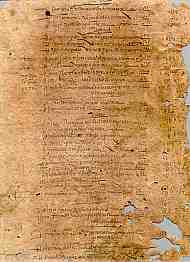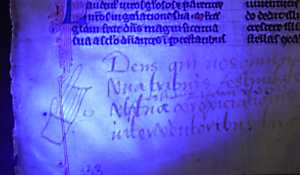




If you are looking at this page without frames, there is more information about medieval writing to be found by going to the home page (framed) or the site map (no frames).
| Handling Manuscripts | |||||
| Manuscripts written on parchment or vellum have proved to be remarkably robust under the right conditions. Liturgical books and books of hours have been thumbed through every day for decades and still survive, or at least the pages do even after the bindings have disintegrated. England's most famous book, Domesday Book, was consulted in its original form for centuries and entries copied out at the behest of folks who thought, often incorrectly, that it gave them some rights or privileges. However, with a diminishing and non-renewable cultural heritage resource, extra care is now needed for all surviving material to ensure that any further losses are minimised. | |||||
 |
The greatest enemies of parchment, apart from that great medieval hazard of the library burning down, are water, acid and insects. The first two can work in collusion, as water or humidity can cause the acids inherent in medieval iron gall ink to dissolve and eat into the underlying parchment. Humidity can also cause the parchment to wrinkle, discolour and lose its flexibility. The sad little leaf at left contains an unfinished sketch for a miniature of Pentecost, not that you can work that out from the image here. Another little interesting relic from the dustbins of history. | ||||
| Damaged leaf from a 15th century book of hours from Italy, from a private collection. | |||||
| If you are granted the privilege of handling medieval manuscripts in a library or archive, you may be required to wear white cotton gloves to protect the parchment from moisture, acid and grease from your skin. This may be enforced with varying degrees of stringency, depending on the viewing conditions in the archive and the frequency with which the manuscript that you are interested in is consulted. Certainly, on some old leaves of books it is possible to see a greasy spot at the page turning point. With my overheated imagination I look at them and wonder if they still contain medieval DNA! Old parchment becomes rigid and cannot be folded and unfolded, so conditions of handling must also allow for the material to be laid out carefully, which can be a problem for some very odd shaped documents such as long rolls. | |||||
| A researcher has teken her interest in greasy fingermarks to a scientific level. Measuring Medieval Dirt is a fascinating peek at some lateral thinking, in which an art historian has examined how people have used their medieval books of hours by measuring how much muck they have left from their fingers on the pages. A longer article can be found in the Journal of Historians of Netherlandish Art. Look up the article Dirty Books in Vol.2, Issue 1-2. Isn't it funny when it seems that somebody has read a stray thought in your mind and turned it into a research project. | |||||
| Paper is a more fragile medium, subject to the same hazards, but the results of damage may be more drastic. Excessive light exposure can also cause discolouration and fragility. The paper page of accounts on the right may have some interest to paleography, but much less to history because of the large holes in vital bits of the information. It lives permanently sealed between stiff archival transparent sheeting otherwise it would rapidly turn to powder. |  |
||||
| 16th century Spanish page of merchant's accounts on paper, from a private collection. | |||||
| Light can also cause fading of ink and of the pigments used for painting initials or miniatures. For this reason manuscripts are kept in low light conditions, even when presented in museum displays. They may have dim lights, or lights which are only turned on briefly when somebody wants to view the object, and fancy illuminated books on display may have the page turned periodically so that one page does not get too much exposure. Archives which allow photography of documents may not allow the use of flash, so it pays to take a tripod and practise some long exposure techniques before you go there. Some libraries or archives will not allow you to take photographs yourself, but may require you to purchase photographs taken by their own photographic department. They may also limit access to handling the documents if photographs or microfilms are available. Others prefer you to take your own photographs, as humble researchers may be more amenable than professional photographers to working under restricted conditions of lighting and handling. These are all aspects to check before you go. There is an increasing tendency for archives and libraries to put large quantities of manuscript material online so that you don't need to even go near the place, let alone handle a manuscript. This may take out a lot of the fun, but it is making masses of material available to more people. | |||||
 |
Faded inscription added to a 13th century Bible leaf in a much later hand, viewed under ultra-violet light, from a private collection. | ||||
| The degree to which ink fades is highly variable, depending upon the original formulation of the ink as well as the conditions of storage over the centuries. Many of those lovely mellow brown inks probably started off black, and sometimes writing has faded into illegibility. In the past certain drastic chemical techniques have been used to increase the legibility of faded documents, but as these have a messy result, better modern alternatives are used. Parchment fluoresces under ultra-violet light, while even tiny traces of ink absorb the light so that even extremely faded writing becomes legible. Archives may have ultra-violet reading lights available for this purpose. The above photograph of a nearly invisible marginal annotation was taken using a small, cheap ultra-violet torch from an invisible writing kit designed for kids. I wouldn't recommend this particular form of the equipment for reading a long document, but it shows that it works. For less drastically faded texts, the use of digital photography and its subsequent manipulation in an image editing program can increase contrasts or even produce false colour images that are more legible than the original. | |||||
 |
Blobs of an unknown substance on a page from a 14th century copy of the Sentences of Peter Lombard, from a private collection. | ||||
| Usually an absolute rule of any archive is that you may only take in pencils for notetaking, not pens. This is so that any little accidental markings are not permanent. The previous owner of the example above thought that the blobs on the page may have been wine, which does evoke a lovely image of a weary monk studying and slurping by candlelight until the cup slipped in his sleepy grasp. Unfortunately, I don't think wine would have retained its rich purple colour over the centuries and the blobs are probably some dropped ink from later centuries. | |||||
| In the case of codices, the bindings themselves may be vulnerable to damage, and if they are tight, it may not be possible to open pages flat. Some very famous books, for example the Book of Kells, have only been photographed in their entirety when they were disbound for repair. Restrictions may be placed on photography and handling of certain books for this reason. | |||||
| If you are fortunate enough to have some old manuscript material of your own, the same basic principles should apply. Storage should be dark and dry and in an acid free medium. There are archival quality transparent envelopes that can be kept in dark coloured binders which can be acquired for this purpose. If you have pieces framed, make sure that fully archival quality acid free material is used for the matting and backing, and keep them in a place with subdued lighting. In general, watch out for anything near them with lots of legs, and if you really just love to have a little feel of the original parchment with your bare fingers (Hey, who doesn't!), keep the coffee, wine and pens at a safe distance. | |||||
 |
Two sides of a sadly mistreated page from a book of hours, from a private collection. | ||||
| The pictures at left show what can happen to a page of vellum with inappropriate treatment. The dark stain along the top border of the upper picture came from glue backing from incorrect tape used for mounting it on a mat. On the lower picture, you can see a bit of tape still adhering and an area of damaged surface where tape has been removed. The brown discolouration, including the spots, are all on one side where the sheet was in contact with a sheet of very nasty brown acidic backing cardboard, obviously not of archival quality. | |||||
| The brown is visible from both sides because the vellum in very fine and translucent. The irony is that the sheet probably survived in good condition for at least 500 years, and the damage occurred over a number of decades. The moral of this story is that if you wish to mount and mat a page of medieval vellum, spend a few bob extra for the archival quality materials, and ask an expert. Anyway, do not worry about this sheet. It has been rescued and placed in a double layer of archival quality plastic sheet protectors in a dark folder. It may last another 500 years or so. | |||||
| For some more detail about these aspects, see the website A Virtual Exhibition of the Ravages of Dust, Water, Moulds, Fungi, Bookworms and other Pests, now apparently only available from The Internet Archive. | |||||
If you are looking at this page without frames, there is more information about medieval writing to be found by going to the home page (framed) or the site map (no frames). |
|||||